Response of Dittany Cultivation to an Organic Fertilization on Nitrogen and Phosphorus Content, Uptake and Use Efficiency
Abstract
1. Introduction
2. Materials and Methods
2.1. Study Area
2.2. Field Experiment
2.3. Measurements
2.4. Nitrogen–Phosphorus Content Analysis
2.5. Nitrogen (N) Indices
2.6. Phosphorus (P) Indices
P-Uptake, P Utilization Efficiency (PUE)
2.7. Statistical Analysis
3. Results
3.1. Nutrient Content
3.2. Nutrient Uptake
3.3. Agronomic Indices of Nitrogen
3.4. Agronomic Indices of Phosphorus
4. Discussion
4.1. Total Nitrogen and Phosphorus Content
4.2. Nitrogen and Phosphorus Uptake
4.3. Nitrogen and Phosphorus Agronomic Indices
5. Conclusions
Author Contributions
Funding
Data Availability Statement
Acknowledgments
Conflicts of Interest
References
- Liolios, C.C.; Graikou, K.; Skaltsa, E.; Chinou, I. Dittany of Crete: A botanical and ethnopharmacological review. J. Ethnopharmacol. 2010, 131, 229–241. [Google Scholar] [CrossRef]
- Solomou, A.; Fountouli, A.; Molla, A.; Petrakis, M.; Manolikaki, I.; Skoufogianni, E. Ecology, Cultivation, and Utilization of the Dittany of Crete (Origanum dictamnus L.) from Ancient Times to the Present: A Short Review. Agronomy 2024, 14, 1066. [Google Scholar] [CrossRef]
- Assariotakis, A.; Tsimpoukas, K.; Tsoukalas, S.; Oikonomou, G. Prospects of Dittany Cultivation in the Area of Embaros, Heraklion. Techno-Economic Analysis. In Proceedings of the 6th Conference of the Hellenic Society for the Genetics and Breeding of Plants (HSGPB), Florina, Greece, 28–30 September 2016. [Google Scholar]
- Molla, A.; Solomou, A.D.; Fountouli, A.; Chatzikirou, E.; Stamatakis, E.; Stamatakis, P.; Skoufogianni, E. Influence of an Organic Fertilizer on Agronomic Characteristics and Herbaceous Plant Diversity in a Greek Ecosystem: The Case of Cretan Dittany (Origanum dictamnus L.). Nitrogen 2024, 5, 426–438. [Google Scholar] [CrossRef]
- Assariotakis, A. Business Plan for Establishing Vertical Integration Processing Unit for Medicinal and Aromatic Plants in Messara; Herakleion Agricultural University of Athens: Athens, Greece, 2024. [Google Scholar]
- Pigott, C.D.; Taylor, K. The Distribution of Some Woodland Herbs in Relation to the Supply of Nitrogen and Phosphorus in the Soil. J. Anim. Ecol. 1964, 33, 175–185. [Google Scholar] [CrossRef]
- Sharma, T.; Kaur, A.; Saajan, S.; Thakur, R. European Journal of Molecular & Clinical Medicine Effect of nitrogen on growth and yield of medicinal plants: A review paper. Eur. J. Mol. Clin. Med. 2022, 7, 2771–2776. [Google Scholar]
- Zhu, Z.; Liang, Z.; Han, R.; Wang, X. Impact of fertilization on drought response in the medicinal herb Bupleurum chinense DC.: Growth and saikosaponin production. Ind. Crops Prod. 2009, 29, 629–633. [Google Scholar] [CrossRef]
- Chrysargyris, A.; Panayiotou, C.; Tzortzakis, N. Nitrogen and phosphorus levels affected plant growth, essential oil composition and antioxidant status of lavender plant (Lavandula angustifolia Mill.). Ind. Crops Prod. 2016, 83, 577–586. [Google Scholar] [CrossRef]
- Cenk, C.; Dilek, A.; Nevin, E.; Özlem, G. Effect of Potassium and Phosphorus Fertilization on Green Herb Yield and Some Quality Traits of Thymus vulgaris L. Afr. J. Agric. Res. 2012, 7, 6427–6431. [Google Scholar] [CrossRef]
- Basal, M.; Elsherif, H.; Ibrahim, A.; El Hamid, N.A. Environmental studies on different nitrogen fertilizers on growth yield and volatile oil of thyme plant. J. Environ. Sci. 2019, 47, 55–75. [Google Scholar] [CrossRef]
- Norouzi, Y.; Ghobadi, M.; Saeidi, M.; Dogan, H. Effect of Nitrogen and Cytokinin on Quantitative and Qualitative Yield of Thyme (Thymus vulgaris L.). Agrotech. Ind. Crops 2021, 1, 52–60. [Google Scholar] [CrossRef]
- Gandomi, A.; Hazrati, S.; Sharafzadeh, S.; Bazrafshan, F. The response of different fertilizer applications on chamomile production and their quality characteristics. Acta Sci. Pol. Hortorum Cultus 2021, 20, 107–119. [Google Scholar] [CrossRef]
- Ahmed, H.H.; El-Sallami, I.H.; Abdul-Hafeez, E.Y.; Ibrahim, O.H. Response of growth, flowering, nutrient uptake and essential oil of German chamomile to organic nutrition. Assiut J. Agric. Sci. 2022, 53, 78–92. [Google Scholar] [CrossRef]
- Chrysargyris, A.; Tzortzakis, N. Optimizing nitrogen, phosphorus, and potassium requirements to improve Origanum dubium Boiss. growth, nutrient and water use efficiency, essential oil yield and composition. Ind. Crops Prod. 2025, 224, 120291. [Google Scholar] [CrossRef]
- Boveiri Dehsheikh, A.; Mahmoodi Sourestani, M.; Zolfaghari, M.; Enayatizamir, N. Changes in soil microbial activity, essential oil quantity, and quality of Thai basil as response to biofertilizers and humic acid. J. Clean. Prod. 2020, 256, 120439. [Google Scholar] [CrossRef]
- Liu, J.; Liu, M.; Fang, H.; Zhang, Q.; Ruan, J. Accumulation of amino acids and flavonoids in young tea shoots is highly correlated with carbon and nitrogen metabolism in roots and mature leaves. Front. Plant Sci. 2021, 12, 756433. [Google Scholar] [CrossRef]
- Javed, T.; I, I.; Singhal, R.K.; Shabbir, R.; Shah, A.N.; Kumar, P.; Jinger, D.; Dharmappa, P.M.; Shad, M.A.; Saha, D. Recent advances in agronomic and physio-molecular approaches for improving nitrogen use efficiency in crop plants. Front. Plant Sci. 2022, 13, 877544. [Google Scholar] [CrossRef]
- Xia, Z.; Gong, Y.; Yang, Y.; Wu, M.; Bai, J.; Zhang, S.; Lu, H. Effects of root-zone warming, nitrogen supply and their interactions on root-shoot growth, nitrogen uptake and photosynthetic physiological characteristics of maize. Plant Physiol. Biochem. 2024, 214, 108887. [Google Scholar] [CrossRef]
- Aduloju, E.I.; Yahaya, N.; Mohammad Zain, N.; Anuar Kamaruddin, M.; Ariffuddin Abd Hamid, M. An overview on the use of deep eutectic solvents for green extraction of some selected bioactive compounds from natural matrices. Adv. J. Chem. Sect. A 2023, 6, 253–300. [Google Scholar]
- Aslam, M.M.; Karanja, J.K.; Dodd, I.C.; Waseem, M.; Weifeng, X. Rhizosheath: An adaptive root trait to improve plant tolerance to phosphorus and water deficits? Plant Cell Environ. 2022, 45, 2861–2874. [Google Scholar] [CrossRef]
- Khan, F.; Siddique, A.B.; Shabala, S.; Zhou, M.; Zhao, C. Phosphorus plays key roles in regulating plants’ physiological responses to abiotic stresses. Plants 2023, 12, 2861. [Google Scholar] [CrossRef]
- Niu, Y.F.; Chai, R.S.; Jin, G.L.; Wang, H.; Tang, C.X.; Zhang, Y.S. Responses of root architecture development to low phosphorus availability: A review. Ann. Bot. 2012, 112, 391–408. [Google Scholar] [CrossRef]
- Prabhuji, S.K.; Wajih, S.A.; Srivastava, G.K.; Tiwari, R.K. Concept of herbal biofertilizer for cultivation of medicinal plants with high quantity and quality secondary metabolites. Med. Plants-Int. J. Phytomed. Relat. Ind. 2020, 12, 169–172. [Google Scholar]
- Akbari, G.A.; Miri, S.A.; Zeinali, H. Investigating the effects of different cultivation media and biological and mineral fertilizers on the yield and active ingredients of ginger medicinal plant (Zingiber officinale Rosc). J. Med. Plants 2022, 21, 75–86. [Google Scholar] [CrossRef]
- Dasgan, H.Y.; Aldiyab, A.; Elgudayem, F.; Ikiz, B.; Gruda, N.S. Effect of biofertilizers on leaf yield, nitrate amount, mineral content and antioxidants of basil (Ocimum basilicum L.) in a floating culture. Sci. Rep. 2022, 12, 20917. [Google Scholar] [CrossRef] [PubMed]
- Bremner, J.; Sparks, D. Methods of Soil Analysis. Part 3. Chemical Methods; Soil Science Society of America: Madison, WI, USA, 1996; pp. 1085–1121. [Google Scholar]
- Miller, R.O. High-Temperature Oxidation: Dry Ashing. Handbook and Reference Methods for Plant Analysis; Kalra, Y., Ed.; CRC Press: New York, NY, USA, 1998. [Google Scholar]
- Chowdhury, M.A.H.; Sultana, T.; Rahman, M.A.; Chowdhury, T.; Enyoh, C.E.; Saha, B.K.; Qingyue, W. Nitrogen use efficiency and critical leaf N concentration of Aloe vera in urea and diammonium phosphate amended soil. Heliyon 2020, 6, e05718. [Google Scholar] [CrossRef]
- de Oliveira Silva, A.; Ciampitti, I.A.; Slafer, G.A.; Lollato, R.P. Nitrogen utilization efficiency in wheat: A global perspective. Eur. J. Agron. 2020, 114, 126008. [Google Scholar] [CrossRef]
- Vanlauwe, B.; Kihara, J.; Chivenge, P.; Pypers, P.; Coe, R.; Six, J. Agronomic use efficiency of N fertilizer in maize-based systems in sub-Saharan Africa within the context of integrated soil fertility management. Plant Soil 2011, 339, 35–50. [Google Scholar] [CrossRef]
- You, L.; Ros, G.H.; Chen, Y.; Shao, Q.; Young, M.D.; Zhang, F.S.; de Vries, W. Global mean nitrogen recovery efficiency in croplands can be enhanced by optimal nutrient, crop and soil management practices. Nat. Commun. 2023, 14, 5747. [Google Scholar] [CrossRef]
- Jiang, L.; Dai, T.; Jiang, D.; Cao, W.; Gan, X.; Wei, S. Characterizing physiological N-use efficiency as influenced by nitrogen management in three rice cultivars. Field Crops Res. 2004, 88, 239–250. [Google Scholar] [CrossRef]
- Dobermann, A.R. Nitrogen Use Efficiency-State of the Art; Agronomy—Faculty Publications: Lincoln, NE, USA, 2005; p. 316. [Google Scholar]
- Roberts, T.L.; Johnston, A.E. Phosphorus use efficiency and management in agriculture. Resour. Conserv. Recycl. 2015, 105, 275–281. [Google Scholar] [CrossRef]
- MacDonald, G.K.; Bennett, E.M.; Potter, P.A.; Ramankutty, N. Agronomic phosphorus imbalances across the world’s croplands. Proc. Natl. Acad. Sci. USA 2011, 108, 3086–3091. [Google Scholar] [CrossRef]
- Ahmed, W.; Liu, K.; Qaswar, M.; Huang, J.; Huang, Q.; Xu, Y.; Ali, S.; Mehmood, S.; Ammar Asghar, R.M.; Mahmood, M.; et al. Long-Term Mineral Fertilization Improved the Grain Yield and Phosphorus Use Efficiency by Changing Soil P Fractions in Ferralic Cambisol. Agronomy 2019, 9, 784. [Google Scholar] [CrossRef]
- Zhao, Q.; Wang, P.; Smith, G.R.; Hu, L.; Liu, X.; Tao, T.; Ma, M.; Averill, C.; Freschet, G.T.; Crowther, T.W.; et al. Nitrogen redistribution and seasonal trait fluctuation facilitate plant N conservation and ecosystem N retention. J. Ecol. 2024, 112, 501–513. [Google Scholar] [CrossRef]
- Wang, Z.; Gong, H.; Sardans, J.; Zhou, Q.; Deng, J.; Niklas, K.J.; Hu, H.; Li, Y.; Ma, Z.; Mipam, T.D.; et al. Divergent nitrogen and phosphorus allocation strategies in terrestrial plant leaves and fine roots: A global meta-analysis. J. Ecol. 2022, 110, 2745–2758. [Google Scholar] [CrossRef]
- Tang, Z.; Xu, W.; Zhou, G.; Bai, Y.; Li, J.; Tang, X.; Chen, D.; Liu, Q.; Ma, W.; Xiong, G.; et al. Patterns of plant carbon, nitrogen, and phosphorus concentration in relation to productivity in China’s terrestrial ecosystems. Proc. Natl. Acad. Sci. USA 2018, 115, 4033–4038. [Google Scholar] [CrossRef] [PubMed]
- Bilias, F.; Ipsilantis, I.; Samara, E.; Tsoktouridis, G.; Glavakis, E.; Grigoriadou, K.; Krigas, N.; Matsi, T. From the wild to the field: Effect of foliar or soil application of inorganic or semi-organic fertilizers on various parameters of four local endemic plant species of Crete (Greece). Braz. J. Bot. 2023, 46, 319–336. [Google Scholar] [CrossRef]
- Cameron, K.C.; Di, H.J.; Moir, J.L. Nitrogen losses from the soil/plant system: A review. Ann. Appl. Biol. 2013, 162, 145–173. [Google Scholar] [CrossRef]
- Musyoka, M.W.; Adamtey, N.; Muriuki, A.W.; Bautze, D.; Karanja, E.N.; Mucheru-Muna, M.; Fiaboe, K.K.M.; Cadisch, G. Nitrogen leaching losses and balances in conventional and organic farming systems in Kenya. Nutr. Cycl. Agroecosyst. 2019, 114, 237–260. [Google Scholar] [CrossRef]
- Mahmud, K.; Panday, D.; Mergoum, A.; Missaoui, A. Nitrogen Losses and Potential Mitigation Strategies for a Sustainable Agroecosystem. Sustainability 2021, 13, 2400. [Google Scholar] [CrossRef]
- He, W.; Zhang, J.; Gao, W.; Chen, Y.; Wei, Z. Enhancing phosphorus availability and dynamics in acidic soils through Rice straw biochar application: A sustainable alternative to chemical fertilizers. Front. Sustain. Food Syst. 2025, 9, 1506609. [Google Scholar] [CrossRef]
- Jin, J.; Fang, Y.; He, S.; Liu, Y.; Liu, C.; Li, F.; Khan, S.; Eltohamy, K.M.; Liu, B.; Liang, X. Improved phosphorus availability and reduced degree of phosphorus saturation by biochar-blended organic fertilizer addition to agricultural field soils. Chemosphere 2023, 317, 137809. [Google Scholar] [CrossRef]
- Folina, A.; Tataridas, A.; Mavroeidis, A.; Kousta, A.; Katsenios, N.; Efthimiadou, A.; Travlos, I.S.; Roussis, I.; Darawsheh, M.K.; Papastylianou, P.; et al. Evaluation of Various Nitrogen Indices in N-Fertilizers with Inhibitors in Field Crops: A Review. Agronomy 2021, 11, 418. [Google Scholar] [CrossRef]
- Mazur, P.; Gozdowski, D.; Wójcik-Gront, E. Soil Electrical Conductivity and Satellite-Derived Vegetation Indices for Evaluation of Phosphorus, Potassium and Magnesium Content, pH, and Delineation of Within-Field Management Zones. Agriculture 2022, 12, 883. [Google Scholar] [CrossRef]
- Xu, G.; Fan, X.; Miller, A.J. Plant Nitrogen Assimilation and Use Efficiency. Annu. Rev. Plant Biol. 2012, 63, 153–182. [Google Scholar] [CrossRef] [PubMed]
- Vaziritabar, Y.; Frei, M.; Yan, F.; Vaziritabar, Y.; Honermeier, B. Enhancing nitrogen use efficiency and plant productivity in long-term precrop/crop rotation and fertilization management. Field Crops Res. 2024, 306, 109210. [Google Scholar] [CrossRef]
- Montemurro, F.; Diacono, M. Towards a Better Understanding of Agronomic Efficiency of Nitrogen: Assessment and Improvement Strategies. Agronomy 2016, 6, 31. [Google Scholar] [CrossRef]
- Fageria, N.K.; Baligar, V.C. Enhancing Nitrogen Use Efficiency in Crop Plants. In Advances in Agronomy; Academic Press: Cambridge, MA, USA, 2005; Volume 88, pp. 97–185. [Google Scholar]
- Kongchum, M.; Harrell, D.L.; Ahmed, A.; Adotey, N.; Leonards, J.; Fluitt, J. Nitrogen fertilization timing and rate influence N recovery efficiency and rice yield. Agron. J. 2024, 116, 3231–3239. [Google Scholar] [CrossRef]
- Zou, H.; Li, D.; Ren, K.; Liu, L.; Zhang, W.; Duan, Y.; Lu, C. Response of maize yield and nitrogen recovery efficiency to nitrogen fertilizer application in field with various soil fertility. Front. Plant Sci. 2024, 15, 1349180. [Google Scholar] [CrossRef]
- Flores-Saavedra, M.; Villanueva, G.; Gramazio, P.; Vilanova, S.; Mauceri, A.; Abenavoli, M.R.; Sunseri, F.; Prohens, J.; Plazas, M. Nitrogen use efficiency, growth and physiological parameters in different tomato genotypes under high and low N fertilisation conditions. Plant Physiol. Biochem. 2024, 208, 108447. [Google Scholar] [CrossRef]
- Smol, M. The importance of sustainable phosphorus management in the circular economy (CE) model: The Polish case study. J. Mater. Cycles Waste Manag. 2019, 21, 227–238. [Google Scholar] [CrossRef]
- Serna, J.; Bergwitz, C. Importance of Dietary Phosphorus for Bone Metabolism and Healthy Aging. Nutrients 2020, 12, 3001. [Google Scholar] [CrossRef]
- Zhang, D.; Zhang, C.; Tang, X.; Li, H.; Zhang, F.; Rengel, Z.; Whalley, W.R.; Davies, W.J.; Shen, J. Increased soil phosphorus availability induced by faba bean root exudation stimulates root growth and phosphorus uptake in neighbouring maize. New Phytol. 2016, 209, 823–831. [Google Scholar] [CrossRef]
- Heuer, S.; Gaxiola, R.; Schilling, R.; Herrera-Estrella, L.; López-Arredondo, D.; Wissuwa, M.; Delhaize, E.; Rouached, H. Improving phosphorus use efficiency: A complex trait with emerging opportunities. Plant J. 2017, 90, 868–885. [Google Scholar] [CrossRef]
- Richardson, A.E.; Lynch, J.P.; Ryan, P.R.; Delhaize, E.; Smith, F.A.; Smith, S.E.; Harvey, P.R.; Ryan, M.H.; Veneklaas, E.J.; Lambers, H.; et al. Plant and microbial strategies to improve the phosphorus efficiency of agriculture. Plant Soil 2011, 349, 121–156. [Google Scholar] [CrossRef]
- Veneklaas, E.J.; Lambers, H.; Bragg, J.; Finnegan, P.M.; Lovelock, C.E.; Plaxton, W.C.; Price, C.A.; Scheible, W.-R.; Shane, M.W.; White, P.J.; et al. Opportunities for improving phosphorus-use efficiency in crop plants. New Phytol. 2012, 195, 306–320. [Google Scholar] [CrossRef]
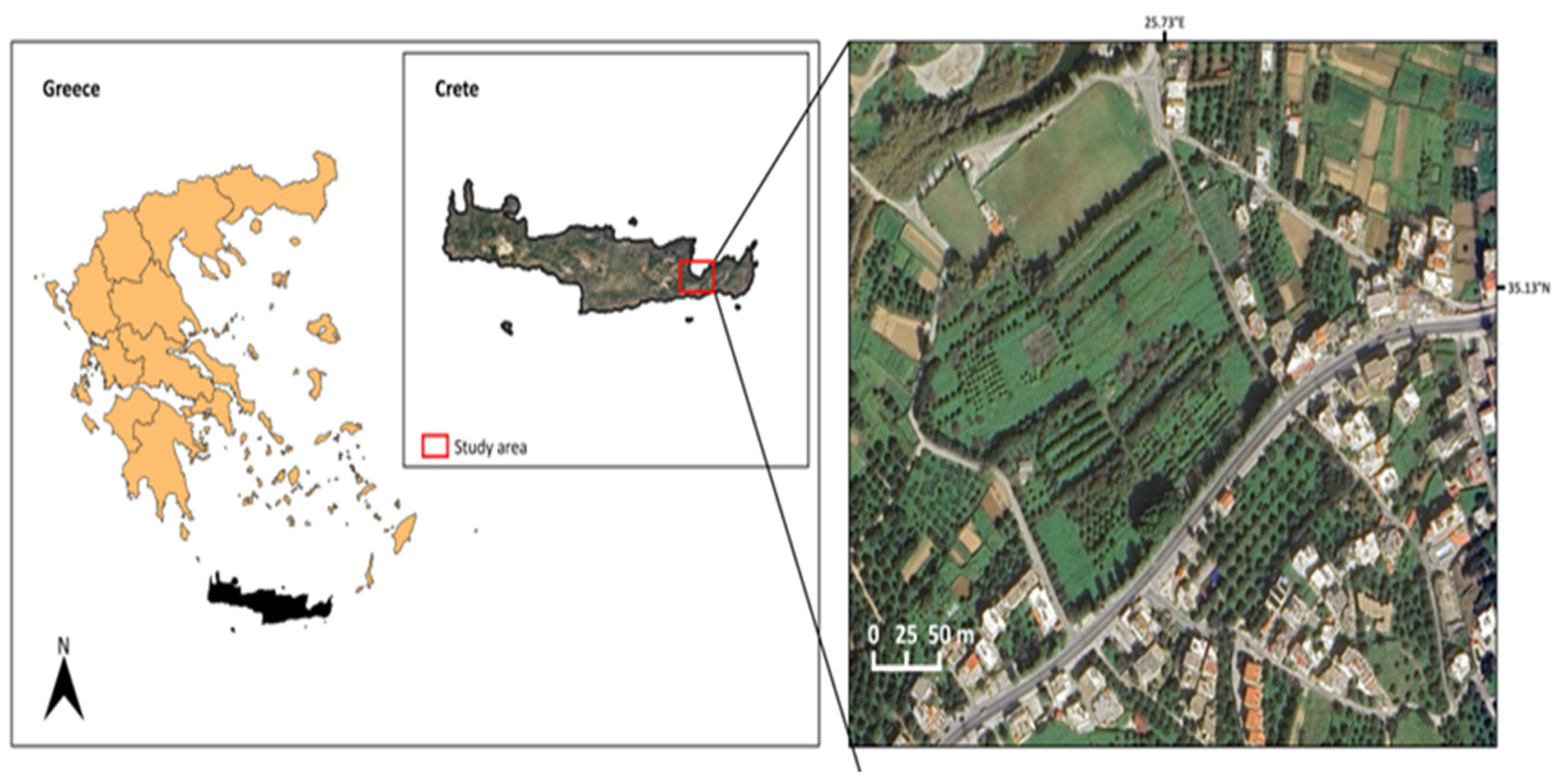

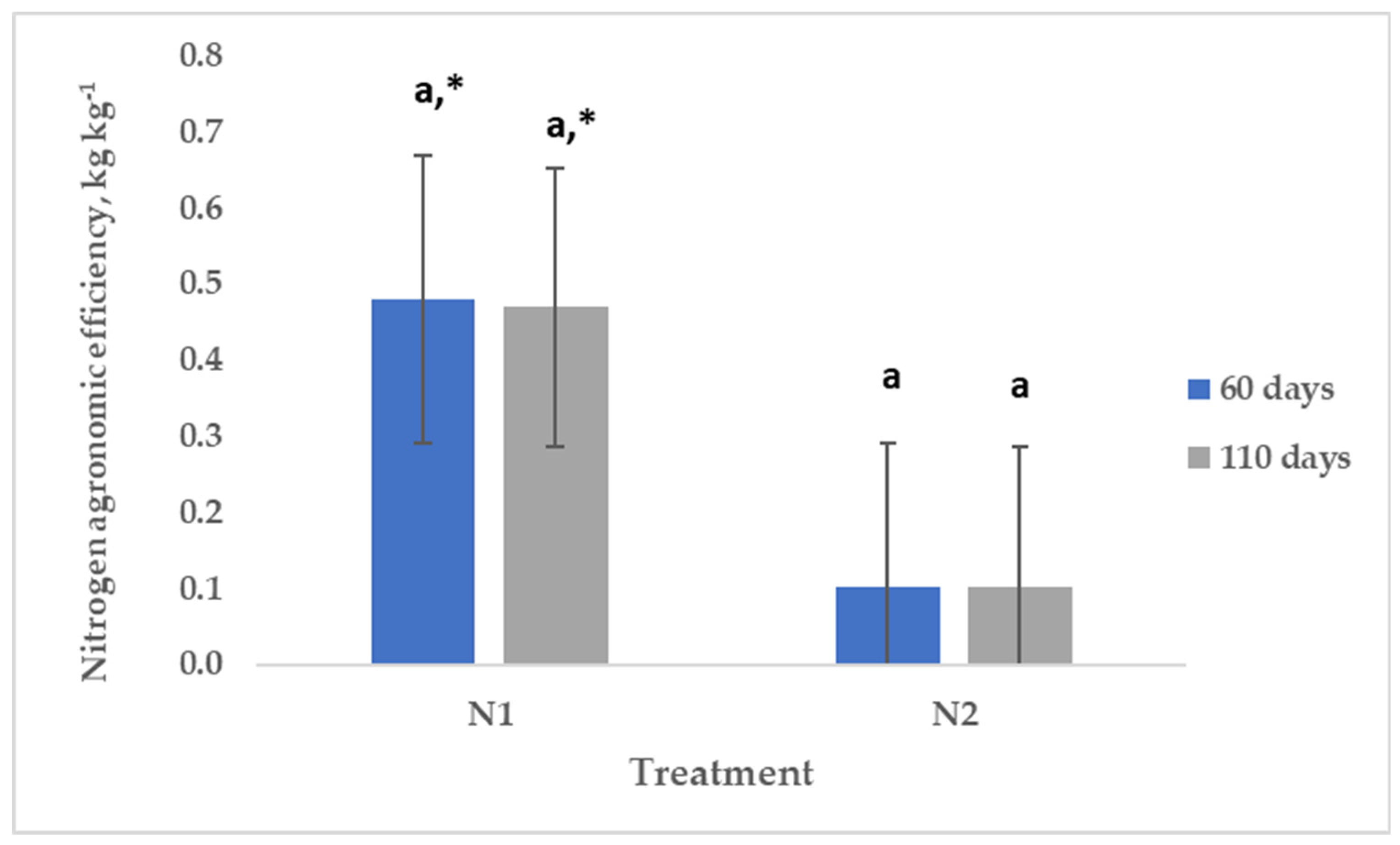
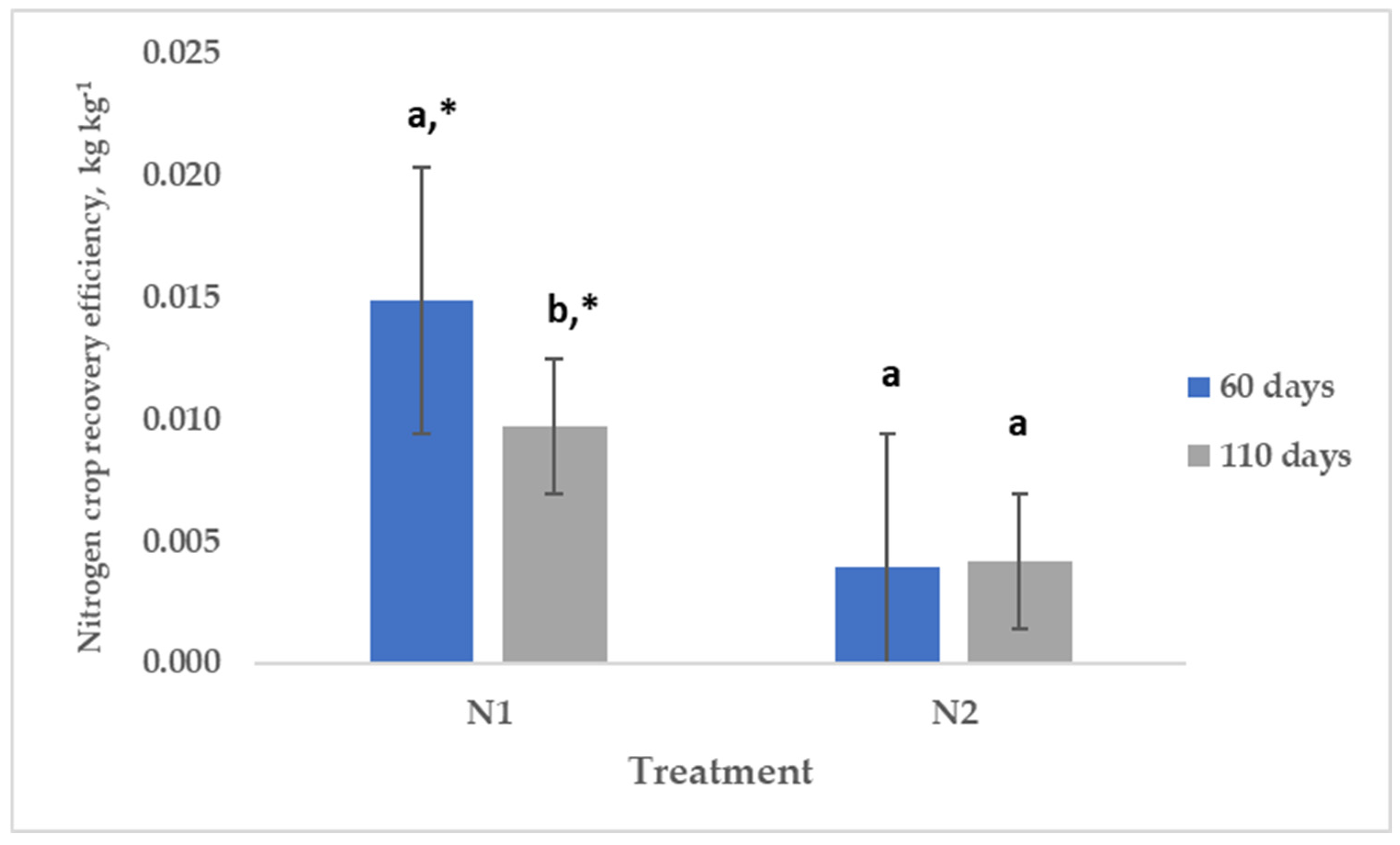


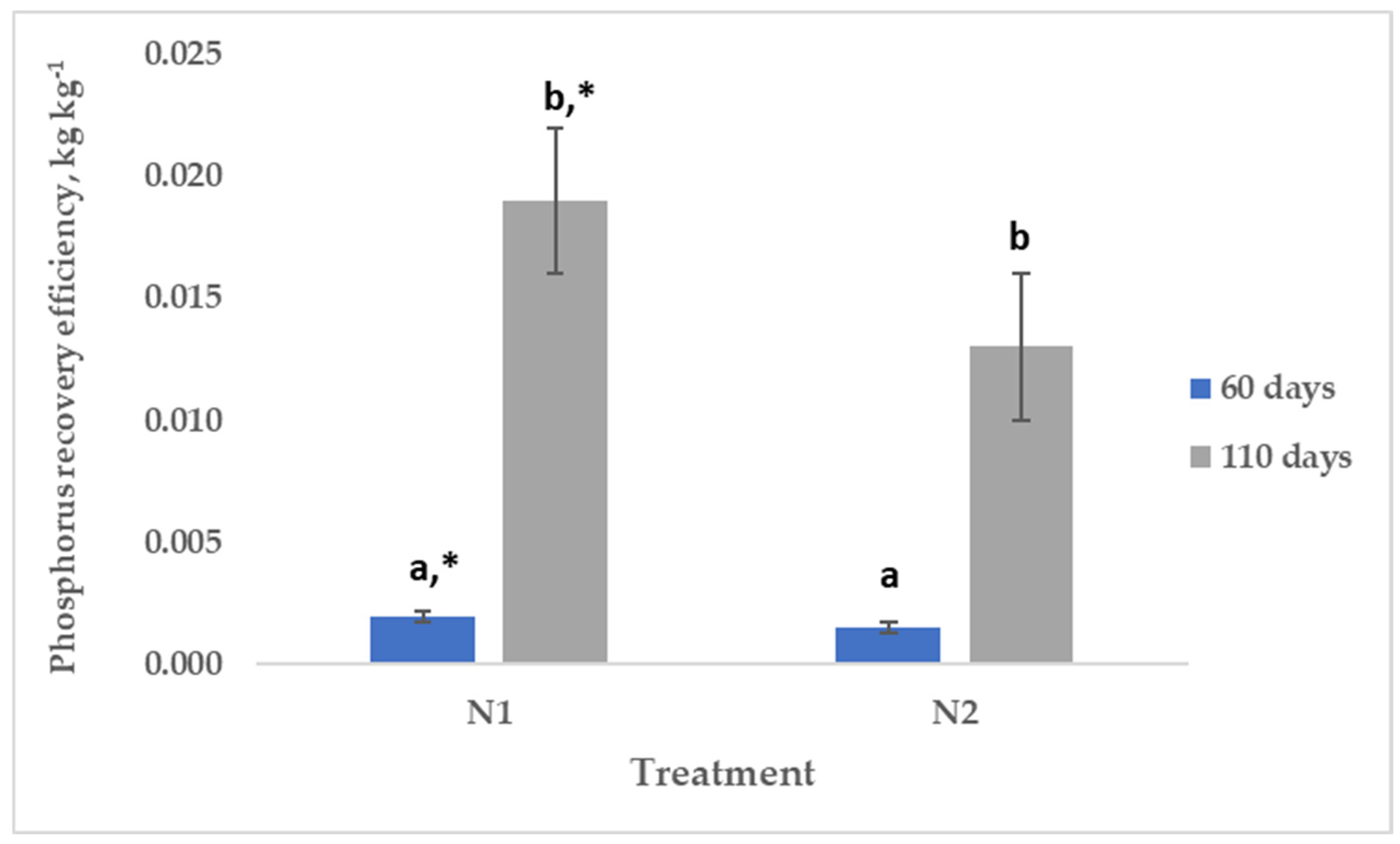
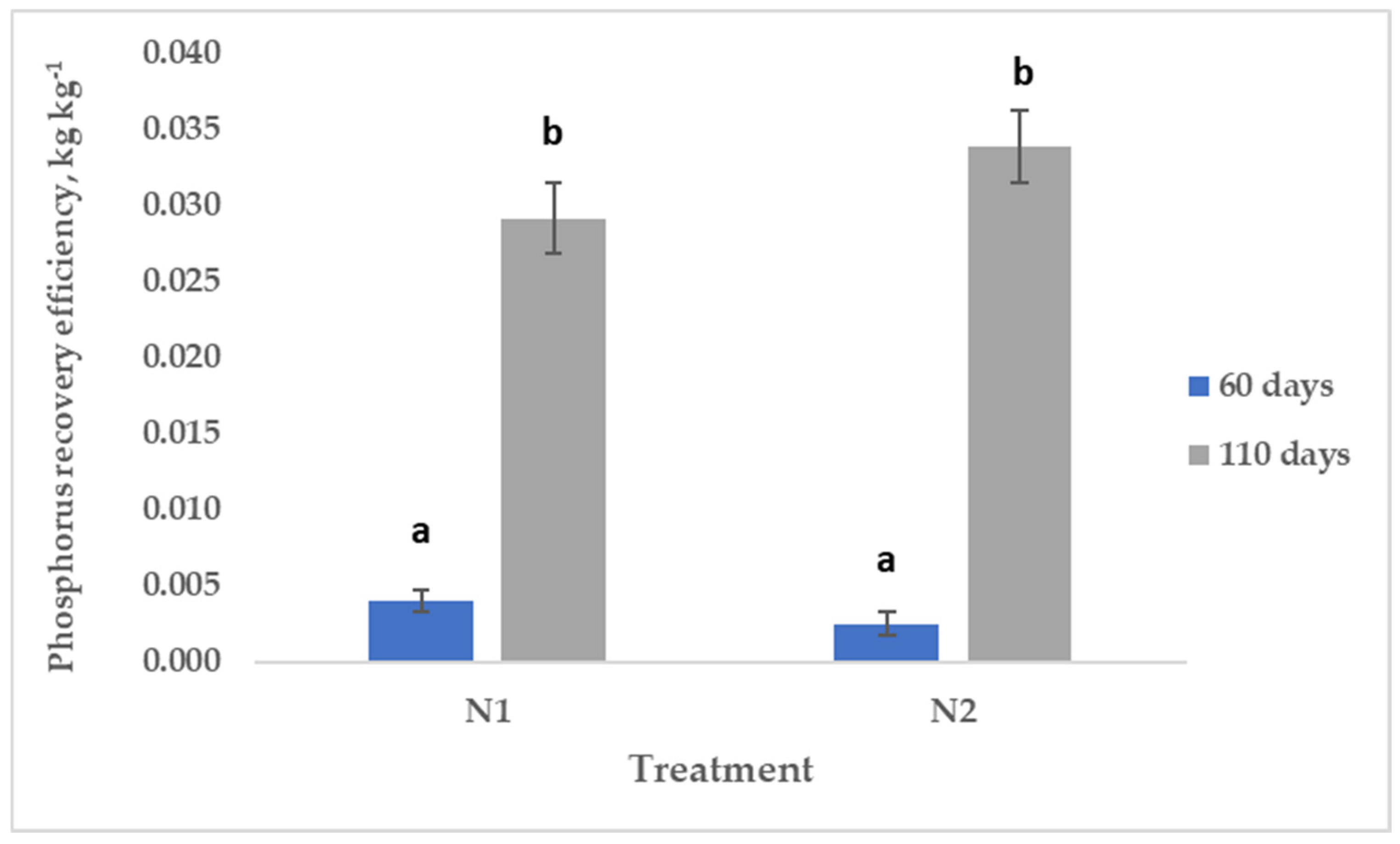
| Total Nitrogen (TN) | ||||
|---|---|---|---|---|
| Treatments | Days after transplant | |||
| 30 days | 60 days | 110 days | ||
| g kg−1 | ||||
| N0 | 17.5 A, a | 19.7 B, a | 18.6 AB, a | |
| N1 | 18.5 A, bc | 24.6 B, b | 19.5 C, a | |
| N2 | 18.7 A, c | 25.9 BC, b | 22.8 C, b | |
| Two-ways ANOVA results | ||||
| df | F | Mean square | Sig | |
| Corrected model | 8 | 22.4 | 91.53 | <0.001 |
| Treatment | 2 | 28.5 | 116.6 | <0.001 |
| Days | 2 | 49.5 | 202.3 | <0.001 |
| Treatment × Days | 4 | 5.7 | 23.6 | <0.001 |
| Phosphorus (P) | ||||
|---|---|---|---|---|
| Treatments | Days after transplant | |||
| 30 days | 60 days | 110 days | ||
| g kg−1 | ||||
| N0 | 2.1 a, A | 2.6 a, AB | 2.3 a, B | |
| N1 | 2.6 b, A | 3.3 b, B | 3.1 b, B | |
| N2 | 2.8 b, A | 3.5 b, C | 3.1 b, B | |
| Two-way ANOVA results | ||||
| df | F | Mean square | Sig | |
| Corrected model | 8 | 16.1 | 2.12 | <0.001 |
| Treatment | 2 | 42.4 | 5.5 | <0.001 |
| Days | 2 | 20.7 | 3.0 | <0.001 |
| Treatment × Days | 4 | 0.7 | 0.1 | 0.5 |
| Nitrogen Uptake, g/plant | ||
|---|---|---|
| Treatments | Days After Transplant | |
| 60 Days | 110 Days | |
| N0 | 0.364 a | 0.337 a |
| N1 | 0.809 b | 0.628 b |
| N2 | 1.044 c | 0.876 c |
| LSD | 0.0143 | 0.0138 |
| Phosphorus Uptake, g/plant | ||
|---|---|---|
| Treatments | Days After Transplant | |
| 60 Days | 110 Days | |
| N0 | 0.047 a | 0.419 a |
| N1 | 0.107 b | 0.989 b |
| N2 | 0.139 c | 1.199 c |
| LSD | 0.0036 | 0.0446 |
Disclaimer/Publisher’s Note: The statements, opinions and data contained in all publications are solely those of the individual author(s) and contributor(s) and not of MDPI and/or the editor(s). MDPI and/or the editor(s) disclaim responsibility for any injury to people or property resulting from any ideas, methods, instructions or products referred to in the content. |
© 2025 by the authors. Licensee MDPI, Basel, Switzerland. This article is an open access article distributed under the terms and conditions of the Creative Commons Attribution (CC BY) license (https://creativecommons.org/licenses/by/4.0/).
Share and Cite
Molla, A.; Fountouli, A.; Emmanouil, C.; Chatzikirou, E.; Skoufogianni, E. Response of Dittany Cultivation to an Organic Fertilization on Nitrogen and Phosphorus Content, Uptake and Use Efficiency. Nitrogen 2025, 6, 58. https://doi.org/10.3390/nitrogen6030058
Molla A, Fountouli A, Emmanouil C, Chatzikirou E, Skoufogianni E. Response of Dittany Cultivation to an Organic Fertilization on Nitrogen and Phosphorus Content, Uptake and Use Efficiency. Nitrogen. 2025; 6(3):58. https://doi.org/10.3390/nitrogen6030058
Chicago/Turabian StyleMolla, Aikaterini, Anastasia Fountouli, Christina Emmanouil, Evaggelia Chatzikirou, and Elpiniki Skoufogianni. 2025. "Response of Dittany Cultivation to an Organic Fertilization on Nitrogen and Phosphorus Content, Uptake and Use Efficiency" Nitrogen 6, no. 3: 58. https://doi.org/10.3390/nitrogen6030058
APA StyleMolla, A., Fountouli, A., Emmanouil, C., Chatzikirou, E., & Skoufogianni, E. (2025). Response of Dittany Cultivation to an Organic Fertilization on Nitrogen and Phosphorus Content, Uptake and Use Efficiency. Nitrogen, 6(3), 58. https://doi.org/10.3390/nitrogen6030058









